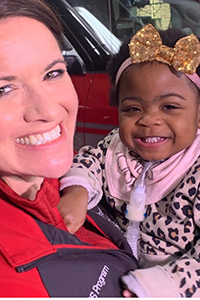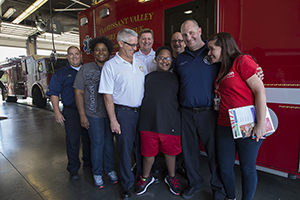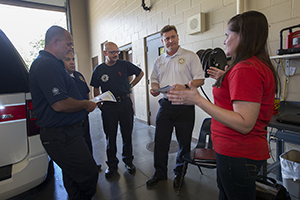By MARY DELACH LEONARD
Patricia Casey adds the hashtag #OneKidCounts to social media posts about her groundbreaking program that connects St. Louis area children who have special health care needs with the first responders who answer their emergencies.

Patricia Casey poses with Carlie, a tracheostomy patient in the Special Needs Tracking and Awareness Response System. Casey organized the STARS program to equip and train EMS personnel in the St. Louis area to respond to emergencies involving medically fragile children.
The hashtag encapsulates Casey's belief that all children are entitled to everything it takes to care for them during an emergency, no matter how complex their medical issues. It has become the motto for the Special Needs Tracking and Awareness Response System, known as STARS, that Casey coordinates at SSM Health Cardinal Glennon Children's Hospital in St. Louis. When children leave the hospital, STARS writes individualized emergency care plans that are shared with EMS personnel in their communities.
Casey, a longtime St. Louis paramedic, helped develop STARS. Like many in the world of emergency medicine, she recognized that most EMS training is geared toward adults and is rarely about children with medical conditions that fall outside traditional emergency protocols. Casey set out to supply first responders with critical information before they arrive at a child's house.
For her trailblazing efforts on behalf of children with specialized medical needs, Casey is the recipient of the 2020 Sister Concilia Moran Award. Named for a visionary leader in Catholic health care, this CHA annual award recognizes an individual who has demonstrated creativity, leadership and breakthrough thinking that advances the Catholic health care ministry. Casey will accept her award in person at the Catholic Health Assembly in Indianapolis next year.
"There is no typical special needs child,'' Casey said. "One of the most important aspects of caring for patients with complex medical needs is knowing what is normal for them. It's tough when you have a kid that doesn't breathe like other kids and doesn't move like other kids and doesn't have the same color because they don't have as much oxygen in their blood.''
STARS now serves more than 700 high-risk children, from infants to 18-year-olds, throughout Missouri and Southern Illinois at no cost to the family and regardless of their child's hospital affiliation. Many of these children depend on home ventilators and tracheostomy tubes. They have medical conditions ranging from severe neurological or genetic disorders to cardiac issues and autism. The STARS database — the first of its kind in the nation — is integrated into 911 dispatching systems so that first responders arrive prepared to provide emergency support.
Connecting EMS and the ER
"If there's ever been a circumstance of one person making a difference for many, this is it,'' said Shawn Dryden, vice president for pediatric ambulatory services for SSM Health at Cardinal Glennon. "It really is a very simple concept. But it is one that's not being met across the country. It has taken somebody like Tricia, who cares enough about this patient population to be willing to take on the 5,000 barriers that have prevented it from being resolved or addressed, up until this point.''

Casey, right, coordinator of the STARS program at SSM Health Cardinal Glennon Children's Hospital, visits a station in the Florissant Valley Fire Protection District in suburban St. Louis along with STARS patient Jason Minor, then 11, and his mother, Anita Minor. Jason has a STARS profile to tell EMS personnel about his medical history and special care requirements. Photo Credit: Karen Elshout/@ CHA
Casey's experience as a paramedic helped her bridge the gap between hospitals and the EMS community, Dryden said.
"Tricia genuinely cares about these children as if they're her own,'' he said. "She makes the time to not only connect to the kids, but to connect with their families. And to connect with the first responder community.''
Casey credits pediatric emergency medicine doctors at Cardinal Glennon for recognizing the value of STARS. She joined the hospital staff five years ago to develop STARS and still works part time as a paramedic with a St. Louis city ambulance unit. She works on the ambulance to keep her skills fresh, and to stay in touch with EMS colleagues, she said. Plus, she loves helping people as a paramedic.
STARS has attracted interest from health care systems around the nation — Dryden says SSM Health is contemplating how to deploy its STARS database not just across this region, but across the country. Casey frequently speaks about the program at conferences.
Special needs, extra consideration
"There is no 'Easy' button,'' Casey said about the preparation required to respond with maximum competence to the acute needs of chronically ill children in an emergency. "Everybody's been looking for an 'Easy' button to fix this for years. It's actually going to take education and time and each child must have a team of people to develop their emergency plan. That's just how it is."

Casey, right, explains some of the needs of her patient, Jason Minor, to Florissant firefighters during a visit to their firehouse in 2016. Firefighters John Herman, Capt. Bob Tresch, Steve Tuley, and Chief Medical Officer Mark Flauter listen in. Photo Credit: Karen Elshout/@ CHA
Casey points to a 2016 survey in which 62 percent of St. Louis area paramedics reported no formal training on tracheostomy emergencies. So, training is a key component of STARS.
Casey can't point to one lightbulb moment that inspired her to develop STARS. There were many.
"It's something that I was aware of very early in my EMS career — the gap of knowledge. And, not just for pediatrics but for any patient who had special needs,'' she said.
Casey remembered seeing her father, who had a rare neurological disorder, struggle to get appropriate emergency health care.
"The emergency room became a frightening, uncomfortable place, and you could not wait to get out of there, and back to your specialist who could actually manage your loved one's care,'' she said.
Ask the experts
During EMS training, Casey worked in a hospital's ICU department with patients who needed ventilators and tracheostomy tubes.
"So, I had a special consideration for people with ventilators and tracheostomies because that's their airways — that's what keeps them alive,'' she said. "I always made sure to immediately go to their caregivers and include them in the care. I would ask, 'Hey, what do you see going on? Do you see that he's deviating from his normal state?'''
Casey also experienced emergency medicine from a parent's perspective after one of her daughters was born with a rare form of epilepsy and a mild bleeding disorder.
"Her seizures are not typical, and a lot of physicians or nurses in emergency rooms would not recognize that she was having a seizure,'' Casey said. "So that really, really worried me that I would be at work and she would potentially be having a seizure and no one would recognize it.''
After a fellow paramedic who lived in her district had a baby with cardiac and lung issues, Casey began searching for a solution.
"This was a baby coming home to the district that I worked in, and I really wasn't comfortable,'' she said. "I didn't know what type of emergencies he was likely to have and I didn't know how to fix them.''
Scared to death
At first, Casey used an emergency information form for special needs pediatric patients developed by the American Academy of Pediatrics. She created a color-coded folder system so dispatchers could relay information to paramedics responding to calls.
Today, even as the STARS program has adopted more sophisticated technology, Casey remains focused on the basics: ensuring that emergency care for frail children is appropriate to their needs because they can be harmed by overtreatment, as well as undertreatment.
For parents like Jamie Masinelli, whose son has special medical needs, STARS has been life changing. Her comments were among the tributes included in the form nominating Casey for the Sister Concilia Moran Award.
"It means that I can call 911 and just be his mom,'' Masinelli stated. "If I'm calling 911, it's because I know I can't get him to the hospital in enough time and I am scared to death for my son.''
Until STARS trained her local EMS personnel, Masinelli felt it was her responsibility to get her son to the hospital.
"STARS removed the burden from us, and we are so grateful. It is comforting to know that I can call 911 and give his STARS number and they can pull up his medications and have his emergency care plan in front of them before they even arrive at our house."
Know your patient
Chris Torno, a firefighter and paramedic, works with Casey in his role as STARS coordinator with the Eureka, Missouri, Fire Protection District. About 15 children in the district are enrolled in the program.
"Any question we have, Tricia is just a text message, phone call or email away,'' Torno said. "Coming from EMS herself, she knows the different things that we need to know before we even see the patient.''
Several times a year, Casey conducts training sessions for the district and encourages the first responders to meet with STARS children before they have an emergency.
Most of the district's emergency calls are to assist adults, including many older adults, Torno said. Their needs are very different from STARS patients.
"With the STARS program, we have set guidelines,'' he said. "It really takes the stress of the call off your back and allows you to think clearly and provide the highest quality of care.''